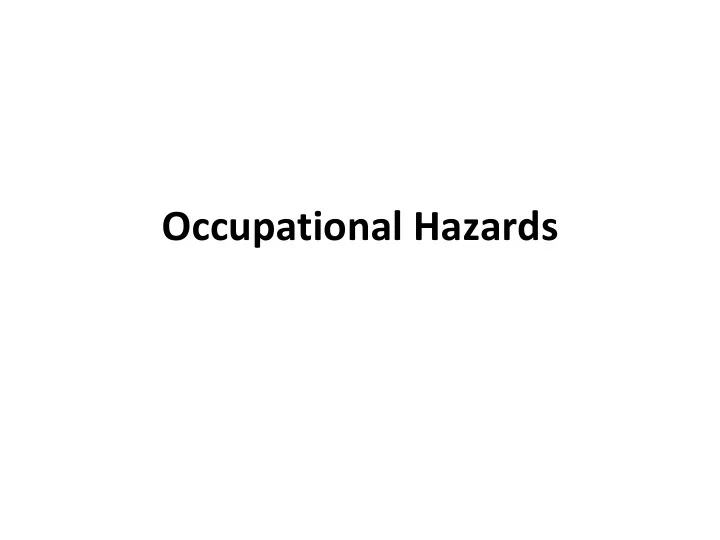

Occupational Hazards
Pneumoconiosis • Group of lung diseases occurring out of specific occupation, caused by inhalation of insoluble dust , over a prolonged period of exposure. • Characterized by fibrosis of lung parenchyma. • Progressive, permanent, pulmonary pathology. • Persistent cough, progressive breathlessness, reduced working capacity of lung. • Followed by complications like tuberculosis, emphysema, COPD, pulmonary hypertension, cor pulmonale, carcinoma.
• Factors influencing pneumoconiosis: 1. Concentration of dust in air 2. Composition of dust. 3. Size of dust particles 4. Duration of exposure 5. Individual susceptibility (health status)
Silicosis • Silica particles Macrophages Autolysis & Death Fibrogenic factor Fibrogenic reaction in pulmonary interstitium Deposition of collagen & formation of fibrosis Hyalinization of collagen. • Nodular fibrosis ‐ 3 ‐ 4 mm, hard, greyish, frequently in the apex & posterior border of lung. • Silico ‐ tuberculosis
• IP ‐ few mths. to few yrs. • Clinical features ‐ cough, dyspnea, loss of weight, emphysema, hemoptysis. • Diagnosis ‐ X ‐ ray chest (snow storm appearance). • Management ‐ No treatmet • Notifiable disease
Anthracosis (coal worker pneumoconosis) • Pathology – coal dust accumulates just before bronchioles open into alveoli (Coal macule) • Stage I (Simple pneumoconiosis) ‐ ventilatory impairment, atrophy of bronchial smooth muscles, dilation of bronchioles causing focal emphysema. • Stage II (Progressive massive fibrosis) ‐ Pulmonary hypertension & cor pulmonale leading to cardiac failure & death.
• Predisposing factors ‐ Tuberculosis, smoking, non specific respiratory infections, autoimmunity. • Beat elbow/ beat knee, Miner’s nystagmus • X ‐ ray shows multiple nodular densities (Black lung)
Asbestosis 1.Serpentine ‐ white asbestos 2.Amphibole ‐ Crocidolite (blue), amosite (brown) • Fibrosis around terminal bronchioles • Tissue reaction is due to mechanical irritation usually in lower half of lung. • Pleural calcification, neoplasm (bronchogenic carcinoma) • X ‐ ray – ground glass appearance • Sputum ‐ asbestos bodies.
Byssinosis • Inhalation of cotton dust. • Tightness of chest, altered respiratory function, chronic cough, progressive dyspnea, emphysema. Bagassosis (cane sugar) • Thermoactinomyces sacchari • IP ‐ 2 ‐ 4 months • X ‐ ray shows mottling appearance
Farmer’s lung • Mouldy hay or grain dust in agriculture field. • Moisture ‐ 30%, Temp. ‐ 45 c • Thermophiliic actinomycete fungi (Microspora faeni) • Allergic reaction • Bronchial asthma • Repeated attacks causes pulmonary fibrosis & lung damage (cor pulmonale) • X ray shows fine nodular density.
Prevention • Health Promotion 1.Pre ‐ placement examination 2.Health education 3.Provision of healthy physical environment 4.Control of dust ‐ prevention of formation ‐ prevention of escape of dust ‐ Removal of dust
• Specific protection • Early diagnosis & treatment • Disability limitation • Rehabilitation
Lead Poisoning • Sources ‐ Mines of lead ore, industries of glass, paint, batteries, plumbing material ‐ Absorption ‐ Inhalation, ingestion ‐ Storage ‐ Bones, liver & kidney ‐ Elimination ‐ 90% non ‐ absorbed in stools • Clinical features ‐ Toxic affect appears if level exceeds 70 mcg/ 100 ml. • Involvement of CNS: insomnia, headache, mental confusion, irritability, nervousness, anxiety, convulsions, delirium, coma, death.
• IUGR • Children ‐ growth failure, progressive mental retardation, low IQ, aggressive behavior, lack of concentration. • Diagnosis ‐ History, clinical symptomatology, investigation (PBS, Hb, blood level of lead, urinary level of lead)
Management 1.Prevention of further exposure 2.Saline purge 3.Chelating agents as Ca ‐ EDTA, d ‐ penicillamine Prevention & Control Health Promotion 1.Preplacement examination 2.Improvement of sanitation 3.Control of dust 4.Unleaded petrol for automobiles 5.Health education
• Specific protection Gloves in painters Respirators • Early diagnosis & treatment • Disability limitation • Rehabilitation
Occupational cancers • Agent ‐ Chemicals • Environmental factors ‐ heat, radiation • Influencing factors • Features • Prevention 1.Preplacement examination 2.Sanitation 3.Health education 4.Protective device ‐ lead apron, gloves, dosimeter
Occupational dermatosis ‐ dermatitis, eczema, folliculitis, urticaria, cancer Physical agents: heat, radiations • Chemical agents: acids, alkalies, dye • Host factor: young, males, summers, lack • of hygiene • Prevention
Agricultural industry 1.Physical hazards 2.Chemical hazards 3.Biological hazards 4.Mechanical hazards 5.Social hazards 6.Miscellaneous
Recommend
More recommend